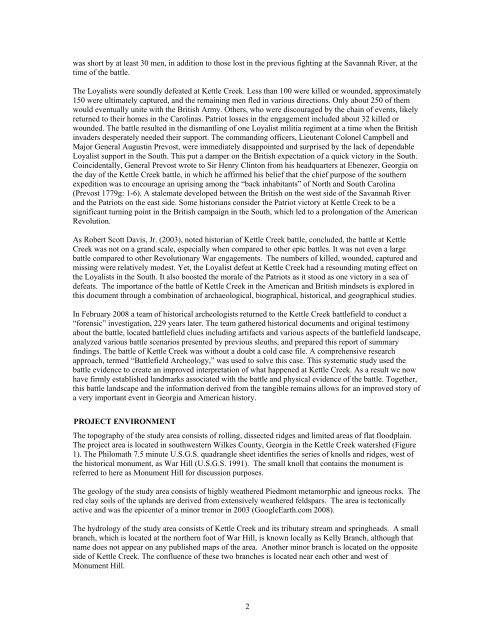Stirring Up a Hornet's Nest: - UGA Laboratory of Archaeology ...
Stirring Up a Hornet's Nest: - UGA Laboratory of Archaeology ...
Stirring Up a Hornet's Nest: - UGA Laboratory of Archaeology ...
Create successful ePaper yourself
Turn your PDF publications into a flip-book with our unique Google optimized e-Paper software.
was short by at least 30 men, in addition to those lost in the previous fighting at the Savannah River, at the<br />
time <strong>of</strong> the battle.<br />
The Loyalists were soundly defeated at Kettle Creek. Less than 100 were killed or wounded, approximately<br />
150 were ultimately captured, and the remaining men fled in various directions. Only about 250 <strong>of</strong> them<br />
would eventually unite with the British Army. Others, who were discouraged by the chain <strong>of</strong> events, likely<br />
returned to their homes in the Carolinas. Patriot losses in the engagement included about 32 killed or<br />
wounded. The battle resulted in the dismantling <strong>of</strong> one Loyalist militia regiment at a time when the British<br />
invaders desperately needed their support. The commanding <strong>of</strong>ficers, Lieutenant Colonel Campbell and<br />
Major General Augustin Prevost, were immediately disappointed and surprised by the lack <strong>of</strong> dependable<br />
Loyalist support in the South. This put a damper on the British expectation <strong>of</strong> a quick victory in the South.<br />
Coincidentally, General Prevost wrote to Sir Henry Clinton from his headquarters at Ebenezer, Georgia on<br />
the day <strong>of</strong> the Kettle Creek battle, in which he affirmed his belief that the chief purpose <strong>of</strong> the southern<br />
expedition was to encourage an uprising among the “back inhabitants” <strong>of</strong> North and South Carolina<br />
(Prevost 1779g: 1-6). A stalemate developed between the British on the west side <strong>of</strong> the Savannah River<br />
and the Patriots on the east side. Some historians consider the Patriot victory at Kettle Creek to be a<br />
significant turning point in the British campaign in the South, which led to a prolongation <strong>of</strong> the American<br />
Revolution.<br />
As Robert Scott Davis, Jr. (2003), noted historian <strong>of</strong> Kettle Creek battle, concluded, the battle at Kettle<br />
Creek was not on a grand scale, especially when compared to other epic battles. It was not even a large<br />
battle compared to other Revolutionary War engagements. The numbers <strong>of</strong> killed, wounded, captured and<br />
missing were relatively modest. Yet, the Loyalist defeat at Kettle Creek had a resounding muting effect on<br />
the Loyalists in the South. It also boosted the morale <strong>of</strong> the Patriots as it stood as one victory in a sea <strong>of</strong><br />
defeats. The importance <strong>of</strong> the battle <strong>of</strong> Kettle Creek in the American and British mindsets is explored in<br />
this document through a combination <strong>of</strong> archaeological, biographical, historical, and geographical studies.<br />
In February 2008 a team <strong>of</strong> historical archeologists returned to the Kettle Creek battlefield to conduct a<br />
“forensic” investigation, 229 years later. The team gathered historical documents and original testimony<br />
about the battle, located battlefield clues including artifacts and various aspects <strong>of</strong> the battlefield landscape,<br />
analyzed various battle scenarios presented by previous sleuths, and prepared this report <strong>of</strong> summary<br />
findings. The battle <strong>of</strong> Kettle Creek was without a doubt a cold case file. A comprehensive research<br />
approach, termed “Battlefield Archeology,” was used to solve this case. This systematic study used the<br />
battle evidence to create an improved interpretation <strong>of</strong> what happened at Kettle Creek. As a result we now<br />
have firmly established landmarks associated with the battle and physical evidence <strong>of</strong> the battle. Together,<br />
this battle landscape and the information derived from the tangible remains allows for an improved story <strong>of</strong><br />
a very important event in Georgia and American history.<br />
BPROJECT ENVIRONMENT<br />
The topography <strong>of</strong> the study area consists <strong>of</strong> rolling, dissected ridges and limited areas <strong>of</strong> flat floodplain.<br />
The project area is located in southwestern Wilkes County, Georgia in the Kettle Creek watershed (Figure<br />
1). The Philomath 7.5 minute U.S.G.S. quadrangle sheet identifies the series <strong>of</strong> knolls and ridges, west <strong>of</strong><br />
the historical monument, as War Hill (U.S.G.S. 1991). The small knoll that contains the monument is<br />
referred to here as Monument Hill for discussion purposes.<br />
The geology <strong>of</strong> the study area consists <strong>of</strong> highly weathered Piedmont metamorphic and igneous rocks. The<br />
red clay soils <strong>of</strong> the uplands are derived from extensively weathered feldspars. The area is tectonically<br />
active and was the epicenter <strong>of</strong> a minor tremor in 2003 (GoogleEarth.com 2008).<br />
The hydrology <strong>of</strong> the study area consists <strong>of</strong> Kettle Creek and its tributary stream and springheads. A small<br />
branch, which is located at the northern foot <strong>of</strong> War Hill, is known locally as Kelly Branch, although that<br />
name does not appear on any published maps <strong>of</strong> the area. Another minor branch is located on the opposite<br />
side <strong>of</strong> Kettle Creek. The confluence <strong>of</strong> these two branches is located near each other and west <strong>of</strong><br />
Monument Hill.<br />
2










